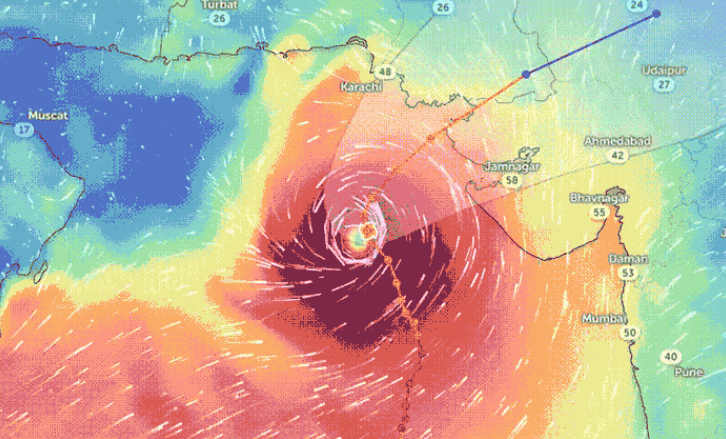Cyclone Biparjoy weakening and end tomorrow
Pak Chronicle Website
Cyclone Biparjoy weakening and end tomorrow: Cyclone Biparjoy, which has been keeping people depressed for several days in Pakistan, will weaken by evening and end tomorrow.
Chief Meteorologist Sardar Sarfaraz has said that the storm may weaken further and turn into a depression by evening.
Sardar Sarfraz has said that Cyclone Buparjoy is moving away from Sindh’s coastline.
According to the National Disaster Management Authority (NDMA), the cyclone is 125 km southwest of Kati Bandar.
According to the NDMA, due to the storm, waves may rise up to 10 to 15 feet in the Northeast Arabian Sea, while waves in Katy Bandar and surrounding areas may rise to 6 to 8 feet.
Karachi, Hyderabad, Tando Muhammad Khan, Tando Al Hiyar, Shaheed Benazirabad and Sanghar are likely to experience strong winds and thundershowers today.
According to the NDMA, winds can blow at a speed of 30 to 50 km per hour, while coastal areas of Sindh and Makran may experience flooding.
The NDMA says that waves may rise up to 2 to 2.5 meters in the coastal areas of Sindh and Makran.
According to the officials, the threat of disaster from the coastal belt of Sindh has been averted, but the forecast of rain remains.
The NDMA says that the districts of Thatta, Sajawal, Badin, Tharparkar, Mirpurkhas and Umarkot are likely to receive rain with strong winds till June 17.
According to NDMA, the cyclone has completed landfall on the coast of Gujarat, India.
According to meteorologist Javad Memon, it is difficult to predict the storm in the Arabian Sea, it is difficult to say definitively at which point the storm in the Arabian Sea will hit.
A sea cyclone, also known as a tropical cyclone or hurricane, is a large-scale weather system characterized by low-pressure centers and organized thunderstorm activity. It typically forms over warm ocean waters near the equator and is fueled by the release of heat energy from the warm water.
Sea cyclones like Cyclone Biparjoy are capable of producing strong winds, heavy rainfall, storm surges, and high waves, making them potentially dangerous and destructive. They are categorized based on their maximum sustained wind speed using various regional classification systems such as the Saffir-Simpson Hurricane Wind Scale (used in the Atlantic and eastern Pacific) or the Australian Tropical Cyclone Intensity Scale.
These cyclones can cause significant damage to coastal areas and can have severe impacts on human populations, infrastructure, and natural ecosystems. Proper forecasting, early warning systems, and preparedness measures are crucial in mitigating the risks associated with sea cyclones.
Ends



